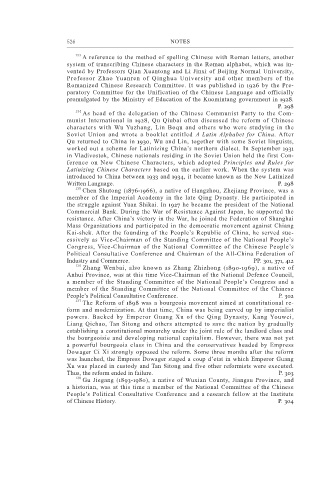Page 528 - SELECTED WORKS OF ZHOU ENLAI Volume II
P. 528
526 NOTES
133 A reference to the method of spelling Chinese with Roman letters, another
system of transcribing Chinese characters in the Roman alphabet, which was in-
vented by Professors Qian Xuantong and Li Jinxi of Beijing Normal University,
Professor Zhao Yuanren of Qinghua University and other members of the
Romanized Chinese Research Committee. It was published in 1926 by the Pre-
paratory Committee for the Unification of the Chinese Language and officially
promulgated by the Ministry of Education of the Kuomintang government in 1928.
P. 298
134 As head of the delegation of the Chinese Communist Party to the Com-
munist International in 1928, Qu Qiubai often discussed the reform of Chinese
characters with Wu Yuzhang, Lin Boqu and others who were studying in the
Soviet Union and wrote a booklet entitled A Latin Alphabet for China. After
Qu returned to China in 1930, Wu and Lin, together with some Soviet linguists,
worked out a scheme for Latinizing China’s northern dialect. In September 1931
in Vladivostok, Chinese nationals residing in the Soviet Union held the first Con-
ference on New Chinese Characters, which adopted Principles and Rules for
Latinizing Chinese Characters based on the earlier work. When the system was
introduced to China between 1933 and 1934, it became known as the New Latinized
Written Language. P. 298
135 Chen Shutong (1876-1966), a native of Hangzhou, Zhejiang Province, was a
member of the Imperial Academy in the late Qing Dynasty. He participated in
the struggle against Yuan Shikai. In 1927 he became the president of the National
Commercial Bank. During the War of Resistance Against Japan, he supported the
resistance. After China’s victory in the War, he joined the Federation of Shanghai
Mass Organizations and participated in the democratic movement against Chiang
Kai-shek. After the founding of the People’s Republic of China, he served suc-
essively as Vice-Chairman of the Standing Committee of the National People’s
Congress, Vice-Chairman of the National Committee of the Chinese People’s
Political Consultative Conference and Chairman of the All-China Federation of
Industry and Commerce. PP. 301, 371, 412
136 Zhang Wenbai, also known as Zhang Zhizhong (1890-1969), a native of
Anhui Province, was at this time Vice-Chairman of the National Defence Council,
a member of the Standing Committee of the National People’s Congress and a
member of the Standing Committee of the National Committee of the Chinese
People’s Political Consultative Conference. P. 302
137 The Reform of 1898 was a bourgeois movement aimed at constitutional re-
form and modernization. At that time, China was being carved up by imperialist
powers. Backed by Emperor Guang Xu of the Qing Dynasty, Kang Youwei,
Liang Qichao, Tan Sitong and others attempted to save the nation by gradually
establishing a constitutional monarchy under the joint rule of the landlord class and
the bourgeoisie and developing national capitalism. However, there was not yet
a powerful bourgeois class in China and the conservatives headed by Empress
Dowager Ci Xi strongly opposed the reform. Some three months after the reform
was launched, the Empress Dowager staged a coup d’etat in which Emperor Guang
Xu was placed in custody and Tan Sitong and five other reformists were executed.
Thus, the reform ended in failure. P. 303
138 Gu Jiegang (1893-1980), a native of Wuxian County, Jiangsu Province, and
a historian, was at this time a member of the National Committee of the Chinese
People’s Political Consultative Conference and a research fellow at the Institute
of Chinese History. P. 304

